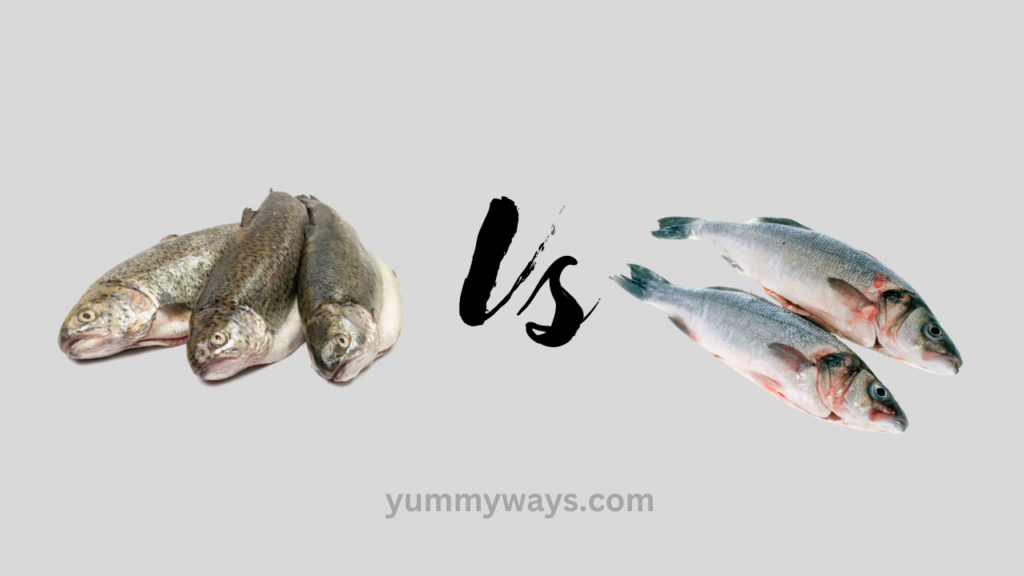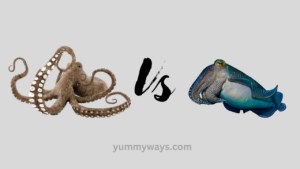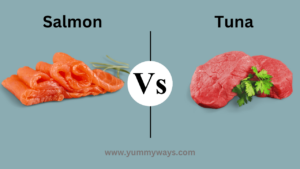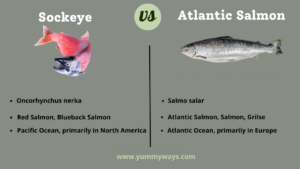Steelhead trout and rainbow trout are the same species, Oncorhynchus mykiss, the former being the anadromous (migrating to the ocean and returning to freshwater to spawn) form while the latter refers to the freshwater variety. The steelhead trout can survive in both freshwater and saltwater habitats, while rainbow trout dwell exclusively in freshwater environments.

Also Read: Sockeye vs Atlantic Salmon: Which One Reigns Supreme in Taste and Flavor
Contents
Origin And Habitat
When it comes to the comparison between Steelhead Trout and Rainbow Trout, understanding their origin and habitats plays a crucial role. Both species hold unique characteristics that set them apart, and their distinct origins and habitats contribute to their traits.
Origins Of Steelhead Trout
Steelhead Trout, scientifically known as Oncorhynchus mykiss, are native to the Pacific Ocean. They are primarily found along the coast of North America, from California to Alaska. Steelheads have an anadromous lifestyle, meaning they hatch and spawn in freshwater, then migrate to the ocean to mature before returning to freshwater to reproduce.
Habitats Of Rainbow Trout
Rainbow Trout, also known as Oncorhynchus mykiss irideus, are native to the Pacific Ocean and freshwaters of North America. They are commonly found in cool streams, rivers, and lakes across the continent. Rainbow Trout are renowned for thriving in diverse aquatic habitats, ranging from small, remote mountain streams to larger lakes and rivers.
Physical Characteristics
Steelhead trout and rainbow trout are two closely related species that often confused due to their similarities. However, they do have distinct physical characteristics that set them apart. In this section, we will explore the differences in appearance and size disparities between these two fascinating fish.
Steelhead Trout Vs Rainbow Trout Differences In Appearance
When it comes to the physical appearance, there are a few key differences to note between steelhead trout and rainbow trout. While both species share the same scientific name, Oncorhynchus mykiss, there are subtle variations that can help us differentiate between the two.
Also Read: Salmon vs Tuna Nutrition: Unlock the Power of Oceanic Superfoods
| Physical Characteristic | Steelhead Trout | Rainbow Trout |
|---|---|---|
| Color | Steelhead trout have a darker and more muted coloration, usually ranging from silvery-blue to olive green on their backs, with a white or silver-colored belly. | Rainbow trout, on the other hand, display vibrant and varied colors. They typically have a pink or reddish stripe running along their sides, which gives them their distinctive rainbow-like appearance. |
| Spots | Steelhead trout have fewer spots on their bodies compared to rainbow trout. These spots are typically small and spread out, often appearing faint or barely visible. | Rainbow trout, in contrast, have numerous spots scattered across their entire body, including their dorsal fin, tail, and sides. These spots are more pronounced and darker in color. |
| Size | Steelhead trout tend to be larger and heavier than rainbow trout. They can grow up to 45 inches in length and weigh as much as 55 pounds. | Rainbow trout are generally smaller in size, with an average length ranging from 12 to 20 inches and weighing around 8 pounds. |
As you can see, there are distinct differences in appearance between steelhead trout and rainbow trout. From their coloration and spotting patterns to their size, each species possesses unique physical characteristics that make them easily distinguishable.
Size Disparities
Size plays a significant role in distinguishing steelhead trout from rainbow trout. Steelhead trout, also known as “ocean-going” rainbow trout, are renowned for their larger size. These fish undertake incredible journeys from freshwater rivers to the ocean and back again, which contributes to their substantial growth.
On the other hand, rainbow trout, often referred to as “resident” or “stream-dwelling” rainbow trout, spend their entire lives within freshwater systems. As a result, their size tends to be smaller compared to their migratory counterparts.
It’s worth mentioning that size disparities can vary depending on multiple factors such as habitat, food availability, and genetics. Nonetheless, on average, steelhead trout surpass rainbow trout in both length and weight.
In conclusion, while steelhead trout and rainbow trout share many similarities, there are distinct physical characteristics that differentiate the two. Understanding these differences can enhance your appreciation for these remarkable fish and aid in identifying them in their natural habitats.
Life Cycle
The life cycle of Steelhead Trout and Rainbow Trout encompasses various stages, each unique in its own way. From spawning behaviors to migration patterns, these two species of fish exhibit distinct characteristics at different points in their life cycle.
Comparison Of Spawning Behaviors
When it comes to spawning, Steelhead Trout and Rainbow Trout differ in their behaviors and preferences.
- Steelhead Trout, native to the Pacific Northwest, are anadromous, meaning they are born in freshwater streams, then migrate to the ocean, and finally return to their natal streams to spawn.
- Rainbow Trout, on the other hand, are non-anadromous and spend their entire lives in freshwater.
During the spawning season, Steelhead Trout exhibit a distinctive behavior known as “redd building.” These fish create nests, or redds, by excavating gravel and rocks along the streambed. The female then deposits her eggs into these redds, where they are fertilized by the male.
Rainbow Trout, on the other hand, prefer to deposit their eggs directly onto the gravel without creating redds. The female Rainbow Trout uses her tail to dig a shallow depression in the gravel, known as a “redd scrape,” where she lays her eggs. The male then releases sperm directly onto the eggs for fertilization.
Migration Patterns
Migration patterns play a crucial role in the life cycle of both Steelhead Trout and Rainbow Trout, although their migratory behaviors differ significantly.
- Steelhead Trout undertake remarkable long-distance migrations between freshwater and saltwater environments.
- Rainbow Trout typically stay within freshwater systems and do not migrate extensively.
Steelhead Trout, during their time in the ocean, feed and grow before returning to their natal streams for spawning. These migrations can cover hundreds of miles, and some individuals even cross state lines or national borders.
Rainbow Trout, however, are primarily resident fish that remain in freshwater habitats throughout their lives. They do not migrate to the ocean like Steelhead Trout, making their home in rivers, streams, and lakes.
Understanding the distinctions in the life cycle, spawning behaviors, and migration patterns of Steelhead Trout and Rainbow Trout is essential for fisheries management and conservation efforts. By recognizing and appreciating the various aspects of these species, we can actively work towards ensuring their survival and the preservation of their habitats.
Diet And Feeding Habits
When it comes to Steelhead Trout vs Rainbow Trout, examining their diet and feeding habits can help in understanding these two species better.
Variances In Diet
Steelhead Trout and Rainbow Trout have distinct preferences when it comes to their diet. Steelhead Trout tend to consume a more varied diet compared to Rainbow Trout. They are known to feed on a larger range of organisms, including small fish, insects, and crustaceans.
Feeding Preferences
When it comes to feeding preferences, it’s important to understand the nuances between Steelhead Trout and Rainbow Trout. Steelhead Trout are renowned for their opportunistic feeding behavior, as they often adapt their diets to prevailing conditions in the water, while Rainbow Trout tend to have a more consistent diet, primarily feeding on aquatic insects and small fish.
Also Read: Fish vs Shark: Know The Differences
Fishing And Aquaculture Importance
Understanding the significance of Steelhead Trout and Rainbow Trout in fishing and aquaculture is crucial for both sport fishing enthusiasts and commercial industry professionals. Let’s delve into the specific aspects of their importance in these sectors:
Sport Fishing Value
Steelhead Trout and Rainbow Trout contribute to the excitement and thrill of sport fishing due to their impressive sizes and challenging behavior when caught.
Commercial Aquaculture Significance
Steelhead Trout and Rainbow Trout play a key role in the commercial aquaculture industry, meeting the high demand for quality seafood.
Culinary Aspects
Culinary aspects play a significant role in distinguishing between Steelhead Trout and Rainbow Trout. When it comes to taste and texture variations, these two types of fish offer unique qualities that impact their preparation and cooking methods.
Taste And Texture Variations
Steelhead Trout have a richer flavor compared to Rainbow Trout with a tender, flaky texture. On the other hand, Rainbow Trout tends to have a milder taste and firmer texture.
Cooking Recommendations
For Steelhead Trout, grilling or baking are excellent methods to retain its delicate flavors. Rainbow Trout, on the other hand, is ideal for pan-frying or broiling to enhance its mild taste.
Conservation Status
Threats To Population
Steelhead trout and rainbow trout face significant threats to their population due to habitat destruction, pollution, overfishing, and climate change.
- Habitat Destruction: Urban development and agricultural activities have led to the degradation and loss of critical spawning and rearing habitats for both species.
- Pollution: Industrial waste and agricultural runoff have contaminated waterways, compromising the quality of the trout’s habitats and impacting their survival.
- Overfishing: Exploitation of the trout populations, particularly in commercial fisheries, has led to a decline in their numbers.
- Climate Change: Rising water temperatures and altered precipitation patterns are affecting the availability of suitable habitats for both species.
Conservation Measures
Several conservation measures are being implemented to address the threats faced by steelhead and rainbow trout populations:
- Habitat Restoration: Efforts are underway to restore and protect critical habitats, including the conservation of riparian zones and the removal of barriers to fish migration.
- Water Quality Improvement: Initiatives aimed at reducing pollution from industrial and agricultural sources are being pursued to enhance the quality of the trout’s habitats.
- Fishery Regulations: Implementation of sustainable fishing practices and the enforcement of catch limits and fishing seasons to ensure the long-term viability of trout populations.
- Climate Adaptation Strategies: Research and actions focused on mitigating the impacts of climate change on trout habitats, such as restoring stream flow regimes and promoting temperature-sensitive habitat conservation.
Conclusion
In the battle of Steelhead Trout vs. Rainbow Trout, they both offer unique flavors and characteristics. Whether you prefer the rich, robust taste of Steelhead or the delicate, mild flavor of Rainbow, both options provide a delightful dining experience. Whichever you choose, these versatile fish are a great addition to any meal.


